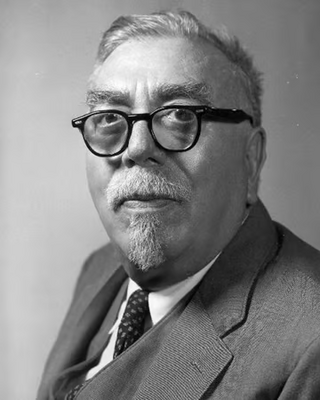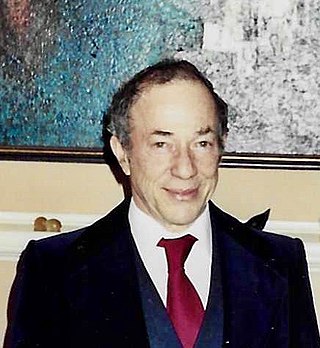Related Research Articles
Harmonic analysis is a branch of mathematics concerned with investigating the connections between a function and its representation in frequency. The frequency representation is found by using the Fourier transform for functions on the real line or by Fourier series for periodic functions. Generalizing these transforms to other domains is generally called Fourier analysis, although the term is sometimes used interchangeably with harmonic analysis. Harmonic analysis has become a vast subject with applications in areas as diverse as number theory, representation theory, signal processing, quantum mechanics, tidal analysis and neuroscience.

Gábor Szegő was a Hungarian-American mathematician. He was one of the foremost mathematical analysts of his generation and made fundamental contributions to the theory of orthogonal polynomials and Toeplitz matrices building on the work of his contemporary Otto Toeplitz.

Norbert Wiener was an American computer scientist, mathematician and philosopher. He became a professor of mathematics at the Massachusetts Institute of Technology (MIT). A child prodigy, Wiener later became an early researcher in stochastic and mathematical noise processes, contributing work relevant to electronic engineering, electronic communication, and control systems.

Mathematical physics refers to the development of mathematical methods for application to problems in physics. The Journal of Mathematical Physics defines the field as "the application of mathematics to problems in physics and the development of mathematical methods suitable for such applications and for the formulation of physical theories". An alternative definition would also include those mathematics that are inspired by physics, known as physical mathematics.

Elias Menachem Stein was an American mathematician who was a leading figure in the field of harmonic analysis. He was the Albert Baldwin Dod Professor of Mathematics, Emeritus, at Princeton University, where he was a faculty member from 1963 until his death in 2018.

William B. Arveson was a mathematician specializing in operator algebras who worked as a professor of Mathematics at the University of California, Berkeley.

Terence Chi-Shen Tao is an Australian and American mathematician who is a professor of mathematics at the University of California, Los Angeles (UCLA), where he holds the James and Carol Collins Chair in the College of Letters and Sciences. His research includes topics in harmonic analysis, partial differential equations, algebraic combinatorics, arithmetic combinatorics, geometric combinatorics, probability theory, compressed sensing and analytic number theory.
The Leroy P. Steele Prizes are awarded every year by the American Mathematical Society, for distinguished research work and writing in the field of mathematics. Since 1993, there has been a formal division into three categories.

Torsten Carleman, born Tage Gillis Torsten Carleman, was a Swedish mathematician, known for his results in classical analysis and its applications. As the director of the Mittag-Leffler Institute for more than two decades, Carleman was the most influential mathematician in Sweden.
In operator theory, von Neumann's inequality, due to John von Neumann, states that, for a fixed contraction T, the polynomial functional calculus map is itself a contraction.

In mathematics, Hilbert spaces allow the methods of linear algebra and calculus to be generalized from (finite-dimensional) Euclidean vector spaces to spaces that may be infinite-dimensional. Hilbert spaces arise naturally and frequently in mathematics and physics, typically as function spaces. Formally, a Hilbert space is a vector space equipped with an inner product that induces a distance function for which the space is a complete metric space. A Hilbert space is a special case of a Banach space.
In the mathematical field of representation theory, a Herz–Schur multiplier is a special kind of mapping from a group to the field of complex numbers.
In mathematics, noncommutative harmonic analysis is the field in which results from Fourier analysis are extended to topological groups that are not commutative. Since locally compact abelian groups have a well-understood theory, Pontryagin duality, which includes the basic structures of Fourier series and Fourier transforms, the major business of non-commutative harmonic analysis is usually taken to be the extension of the theory to all groups G that are locally compact. The case of compact groups is understood, qualitatively and after the Peter–Weyl theorem from the 1920s, as being generally analogous to that of finite groups and their character theory.

Gilles I. Pisier is a professor of mathematics at the Pierre and Marie Curie University and a distinguished professor and A.G. and M.E. Owen Chair of Mathematics at the Texas A&M University. He is known for his contributions to several fields of mathematics, including functional analysis, probability theory, harmonic analysis, and operator theory. He has also made fundamental contributions to the theory of C*-algebras. Gilles is the younger brother of French actress Marie-France Pisier.

Carl Samuel Herz was an American-Canadian mathematician, specializing in harmonic analysis. His name is attached to the Herz–Schur multiplier. He held professorships at Cornell University and McGill University, where he was Peter Redpath Professor of Mathematics at the time of his death.

Cora Susana Sadosky de Goldstein was an Argentine mathematician and Professor of Mathematics at Howard University.

Francis Michael Christ is an American mathematician and professor at University of California, Berkeley, specializing in harmonic analysis, partial differential equations, and several complex variables. He is known for the Christ–Kiselev maximal inequality.

M. Vali Siadat is an Iranian-American mathematician, the Distinguished Professor of Mathematics at Richard J. Daley College.
References
- ↑ "Stephen W Drury". McGill University. Retrieved 2019-02-11.
- ↑ "S. W. Drury – Research Interests" . Retrieved 2019-02-11.
- ↑ "Sam (Stephen William) Drury". Mathematics Genealogy Project.
- ↑ Drury, S.W., 1970, Sur les ensembles de Sidon, C.R. Acad. Sci. Paris, 271, pp. 162–164
- ↑ "Carl Herz 1930–1995" (PDF). American Mathematical Society. Retrieved 29 July 2019.
- ↑ Drury, S.W., 1985. Restriction of Fourier transforms to curves. Ann. Inst. Fourier, 35(1), pp. 117–123.
- ↑ Drury, S.W., 1978. A generalization of von Neumann’s inequality to the complex ball. Proceedings of the American Mathematical Society, 68(3), pp. 300–304.
- ↑ Fang, Quanlei (June 2017). "Operator theory in Drury–Arveson Space" (PDF). Technion – Israel Institute of Technology. Retrieved 29 July 2019.